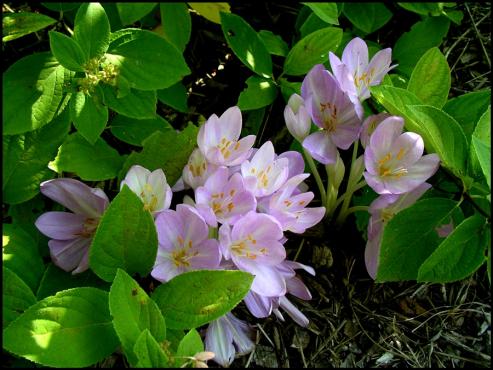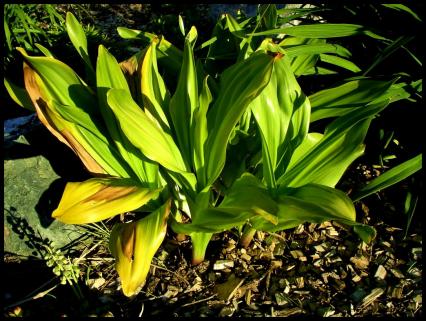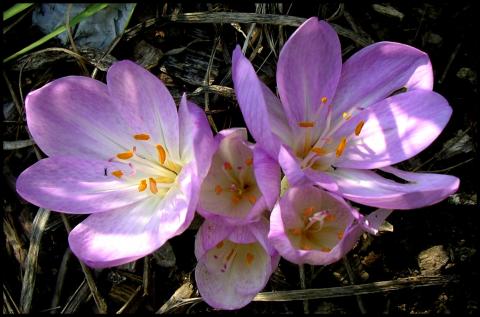Plant of the Month for March, 2013

(KOHL-chi-kum aw-tum-NAH-lee)
General Information:
The flowers look just like a crocus but only show up in the fall which explains its common name of autumn crocus. It is actually a Colchicum, a plant that is unrelated to the true crocus.

Colchicum autumnale planted under an Hydrangea; photo by Robert Pavlis
The pictures are taken from plants that have been handed down without a name. They are probably one of the named varieties and not the true species.
Colchicum autumnale grows leaves in the spring, which then die down in early summer. The plant remains dormant underground until fall at which time leafless flowers appear. Each flower lasts only a few days, but a large corm can have up to 6 flowers which open over seveal weeks. Hybrids are available in a number of shades of pink, mauve and white. It is a refreshing flower to see at a time of year when most other plants are going dormant and brown.

Colchicum autumnale showing spring leaves; photo by Robert Pavlis
Colchicum grow from corms (swollen stem). Although the plants are relatively expensive to buy, they quickly expand by forming new corms underground. After the leaves die down in mid-summer they can be dug up and divided every few years to increase the number of plants.
All parts of the plant are poisonous which may explain why neither squirrels nor deer bother this plant.

Colchicum autumnale; photo by Robert Pavlis
Crocus and Colchicum have very similar flowers except that Colchicum tend to be much larger. Crocus have 3 stamens and their leaves are narrow and grass-like and may have a white line down the center of the leaf. Colchicum have 6 stamens and the leaves are wide, a solid green and look more like leaf lettuce. Flowering time is not a sure way to distinguish between Crocus and Colchicum since both genus have spring and fall flowering species.
Selecting a good spot in the garden can be a bit tricky. They don’t fit into the rock garden very well because of their large leaves. The flowers are short and bloom in the fall, so you don’t want to site them beside plants that will grow taller and hide the flowers. I find that near the drip line of shrubs is a good location. They would also do well beside summer flowering perennials that are cut back in early fall.
Life Cycle: cormous perennial
Height: flower are 20 cm (8 in), leaves are 30 cm (12 in)
Bloom Time: fall
Natural Range: Western and Central Europe
Habitat: meadows and woodland clearings
Synonyms: none.
Cultivation:
Light: full sun, can take some shade
Soil: loam or sandy soil, that is dry in winter
Water: average moisture in spring and fall, dry in summer and winter
USDA Hardiness Zone: 4 - 9
Propagation: seed, division of corm offshoots
Seedex availability (ORG&HPS annual Seed Exchange): rarely (although other Colchicum species are normally available)
Give sown seeds several weeks @ 20°C to imbibe water (perhaps even germinate!), then expose to fluctuating outdoor winter temperatures including freezing for 3 months. Gradually increase light and temperature in spring. See https://www.youtube.com/watch?v=SO_KKbGYTEM
